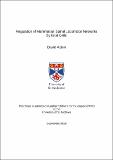Files in this item
Regulation of mammalian spinal locomotor networks by glial cells
Item metadata
| dc.contributor.advisor | Miles, Gareth Brian | |
| dc.contributor.author | Acton, David | |
| dc.coverage.spatial | vii, 186 p. | en_US |
| dc.date.accessioned | 2017-01-20T10:23:04Z | |
| dc.date.available | 2017-01-20T10:23:04Z | |
| dc.date.issued | 2017-06 | |
| dc.identifier.uri | https://hdl.handle.net/10023/10133 | |
| dc.description.abstract | Networks of interneurons within the spinal cord coordinate the rhythmic activation of muscles during locomotion. These networks are subject to extensive neuromodulation, ensuring appropriate behavioural output. Astrocytes are proposed to detect neuronal activity via Gαq-linked G-protein coupled receptors and to secrete neuromodulators in response. However, there is currently a paucity of evidence that astrocytic information processing of this kind is important in behaviour. Here, it is shown that protease-activated receptor-1 (PAR1), a Gαq-linked receptor, is preferentially expressed by glia in the spinal cords of postnatal mice. During ongoing locomotor-related network activity in isolated spinal cords, PAR1 activation stimulates release of adenosine triphosphate (ATP), which is hydrolysed to adenosine extracellularly. Adenosine then activates A1 receptors to reduce the frequency of locomotor-related bursting recorded from ventral roots. This entails inhibition of D1 dopamine receptors, activation of which enhances burst frequency. The effect of A1 blockade scales with network activity, consistent with activity-dependent production of adenosine by glia. Astrocytes also regulate activity by controlling the availability of D-serine or glycine, both of which act as co-agonists of glutamate at N-methyl-D-aspartate receptors (NMDARs). The importance of NMDAR regulation for locomotor-related activity is demonstrated by blockade of NMDARs, which reduces burst frequency and amplitude. Bath-applied D-serine increases the frequency of locomotor-related bursting but not intense synchronous bursting produced by blockade of inhibitory transmission, implying activity-dependent regulation of co-agonist availability. Depletion of endogenous D-serine increases the frequency of locomotor-related but not synchronous bursting, indicating that D-serine is required at a subset of NMDARs expressed by inhibitory interneurons. Blockade of the astrocytic glycine transporter GlyT1 increases the frequency of locomotor-related activity, but application of glycine has no effect, indicating that GlyT1 regulates glycine at excitatory synapses. These results indicate that glia play an important role in regulating the output of spinal locomotor networks. | en_US |
| dc.language.iso | en | en_US |
| dc.publisher | University of St Andrews | |
| dc.relation | Acton, D. and Miles, G. B., 2015. Stimulation of glia reveals modulation of mammalian spinal motor networks by adenosine. PLoS ONE, 10 (8), p. e0134488. (http://hdl.handle.net/10023/7234) | en_US |
| dc.relation.uri | http://hdl.handle.net/10023/7234 | |
| dc.subject | Spinal cord physiology | en_US |
| dc.subject | Locomotion | en_US |
| dc.subject | Central pattern generator | en_US |
| dc.subject | CPG | en_US |
| dc.subject | Motor control | en_US |
| dc.subject | NMDA receptors | en_US |
| dc.subject | Glia | en_US |
| dc.subject | Glial cells | en_US |
| dc.subject | Astrocytes | en_US |
| dc.subject | Neural networks | en_US |
| dc.subject | Gliotransmission | en_US |
| dc.subject | PAR1 | en_US |
| dc.subject | Dopamine | en_US |
| dc.subject | Co-agonist | en_US |
| dc.subject | D-serine | en_US |
| dc.subject | Glycine | en_US |
| dc.subject | GlyT1 | en_US |
| dc.subject.lcc | QP367.A3 | |
| dc.subject.lcsh | Neural networks (Neurobiology) | en |
| dc.subject.lcsh | Neuroglia | en |
| dc.subject.lcsh | Motor neurons | en |
| dc.subject.lcsh | Locomotion--Regulation | en |
| dc.subject.lcsh | Spinal nerves | en |
| dc.subject.lcsh | Spinal cord--Physiology | en |
| dc.title | Regulation of mammalian spinal locomotor networks by glial cells | en_US |
| dc.type | Thesis | en_US |
| dc.contributor.sponsor | Wellcome Trust. Institutional Strategic Support Fund (ISSF) | en_US |
| dc.type.qualificationlevel | Doctoral | en_US |
| dc.type.qualificationname | PhD Doctor of Philosophy | en_US |
| dc.publisher.institution | The University of St Andrews | en_US |
This item appears in the following Collection(s)
Items in the St Andrews Research Repository are protected by copyright, with all rights reserved, unless otherwise indicated.

